Classic Car Road Trip Normandy 2019, 75 years after D-Day: Each five years, members of the Dutch WWII military vehicles owners association Keep Them Rolling are invited by the French municipality of Courseulles-sur-Mer to attend and contribute to the D-Day celebrations and commemorations in Normandy. On the first of June we arrived in Normandy to join the 75th anniversary of D-Day. D-Day took place during WWII, 6 June 1944, when the Western Allied forces landed on the beaches of Normandy. D-Day was the first day of Operation Overlord, the Allied code-name for the successful Western Allied invasion in Normandy and the beginning of the liberation of nazi-Germany occupied Europe. Together with other members of Keep them Rolling, we and our vehicles were accomodated on a specially equipped and guarded camping site. We visited several museums and memorials of the invasion of Normandy and the historic D-Day landing beaches. We visited military cemeteries containing the graves of soldiers who were killed during the battles in Normandy, such as the Bény-sur-Mer Canadian War Cemetery and the Normandy American Cemetery and Memorial, situated in Colleville-sur-Mer. We visited Pointe du Hoc, one of the most impressive locations of the Atlantic Wall, Pointe du Hoc is a 30 metres high cliff situated between Omaha Beach and Utah Beach. We were invited to the Liberty Concert Normandy, a memorial concert which took place on Sword Beach in Ouistreham. The Willys MB Jeep of a friend and our own 1942 Ford GPW Jeep were displayed in front of the tent, where the memorial concert took place. On the 6th of June, a static show of WWII military vehicles was held on the camping area in Courseulles-sur-Mer, organised by the members of Keep Them Rolling. On June 8, after the military vehicle parade, memorial wreaths were thrown into the sea in front of Juno Beach. The 75th anniversary of D-Day was concluded with a water show and a fireworks show.
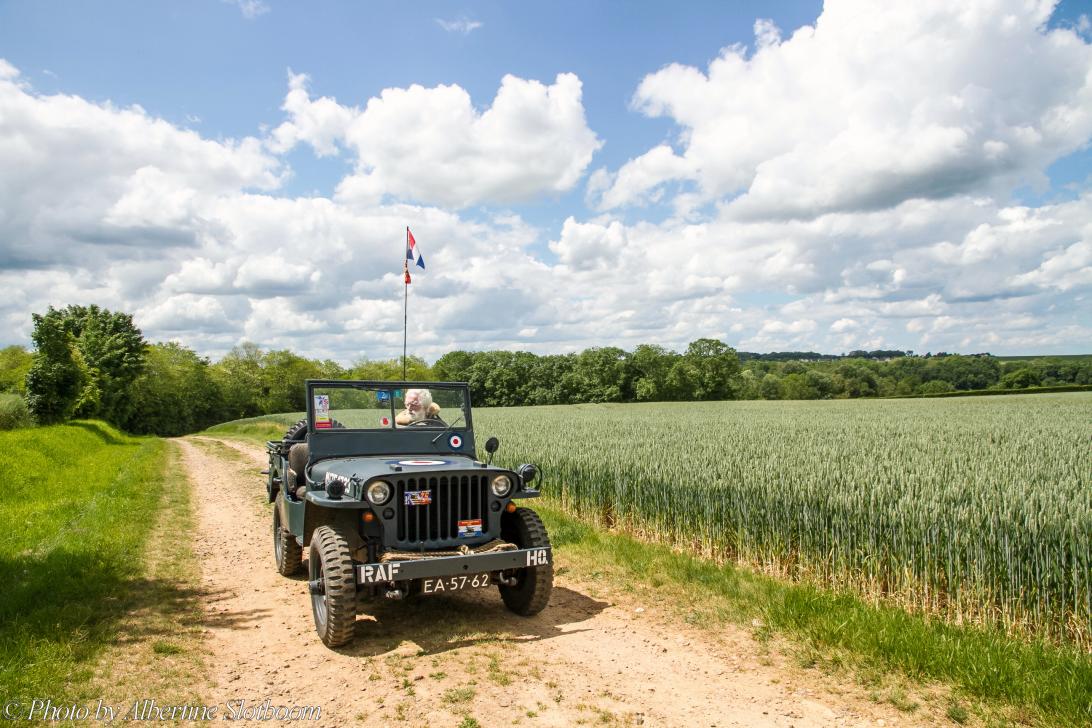
Classic Car Road Trip: With a Ford GPW Jeep to Normandy for the 75th anniversary of D-Day. Each five years, owners of WWII vehicles are invited by French municipalities in Normandy to attend and contribute to the D-Day commemorations. In June 2019, we and the Jeep arrived in Courseulles-sur-Mer to join the 75th anniversary of D-Day. D-Day took place during WWII. D-Day is the first day of Operation Overlord, the code-name for the successful Western Allied invasion in Normandy and the beginning of the liberation of Nazi-Germany occupied Europe.

Classic Car Road Trip: With a Ford GPW Jeep to Normandy for the 75th anniversary of D-Day. Each five years, owners of WWII vehicles are invited by French municipalities in Normandy to attend and contribute to the D-Day commemorations. In June 2019, we and the Jeep arrived in Courseulles-sur-Mer to join the 75th anniversary of D-Day. D-Day took place during WWII. D-Day is the first day of Operation Overlord, the code-name for the successful Western Allied invasion in Normandy and the beginning of the liberation of Nazi-Germany occupied Europe.
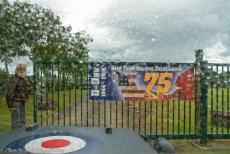
Classic Car Road Trip Normandy, the 75th anniversary of D-Day: Our own Ford GPW Jeep at the gate of the temporary campingsite at Courseulles-sur-Mer in Normandy, France. Together with the other members of Keep them Rolling, we and the WWII vehicles were accomodated on a speciallyequipped and guarded campingsite. From Courseulles-sur-Mer, we went on day trips to visit the historic D-Day landing beaches, museums and memorials along the coast of Normandy.
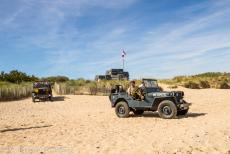
Classic Car Road Trip Normandy, 75 years after D-Day: A Willys MB Jeep and Ford GPW Jeep on Juno Beach. Juno Beach stretches on either side of the municipality of Courseulles-sur-Mer in Normandy, France. During WWII, Juno Beach was the Western Allied code name for one of the five landing beaches along the Normandy coast. On D-Day, the 6th of June 1944, the Western Allied forces landed on the beaches of Normandy.
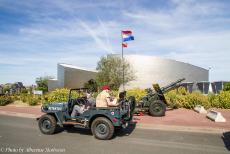
Classic Car Road Trip Normandy, 75 years after D-Day: A 1942 Ford GPW Jeep in front of the Juno Beach Centre in Courseulles-sur-Mer. The Juno Beach Centre is a Canadian WWII museum, situated directly behind Juno Beach, where the 3rd Canadian Infantry Division landed on D-Day, 6th June 1944. The Juno Beach Centre is not only a museum dedicated to the D-Day landings and the participation of Canada in WWII, but also a place of remembrance.
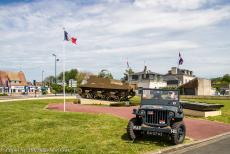
Classic Car Road Trip Normandy, 75 years after D-Day: A WWII Ford Jeep in front of a Sexton self-propelled gun at Ver-sur-Mer. The Sexton was a gift to the small village of Ver-sur-Mer by Mathew Kiln in memory of his father Major Robert Kiln and the British soldiers of the 86th Field Regiment Royal Artillery who landed on D-day on Gold Beach at Ver-sur-Mer. The Sexton stands in a memorial square, called the Espace Robert Kiln. Robert Kiln survived WWII, he died in 1997.
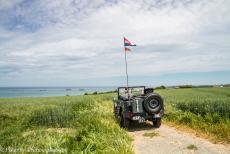
Classic Car Road Trip Normandy, 75 years after D-Day: Our own Jeep on a plateau overlooking Gold Beach at Arromanches-les-Bains, the remains of the temperory Mulberry Harbour in the background. The floating artificial Mulberry Harbours were designed and constructed by British military engineers during WWII. The Mulberry Harbour at Arromanches-les-Bains was used to supply the British and Canadian troops. In the first ten months after D-Day, over 2.5 million men, 500,000 vehicles and 4 million of supplies were landed here.
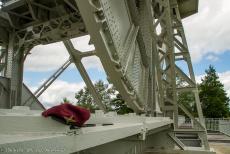
Classic Car Road Trip Normandy, 75 years after D-Day: The original Pegasus Bridge at the Pegasus Memorial Museum at Ranville, the museum is dedicated to the men of 6th Airborne Division, called the Red Berets because of the red berets that they wore in combat. In the early hours of D-Day, men of 6th Airborne Division landed by glider near Ranville and captered the bridge, today known as the Pegasus Bridge. Major John Howard had orders to 'hold the bridge until relieved' by Allied forces moving inland from Sword Beach.
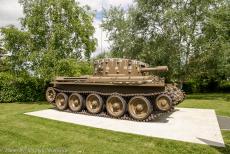
Classic Car Road Trip Normandy, 75 years after D-Day: A Centaur Tank at the Pegasus Memorial Museum at Ranville. The Centaur tank was code-named 'Vidette' by its crew. On D-Day, the tank was immobilised by German gun fire after landing on Sword Beach with the British and French Commando Forces. The tank was restored in the 1970s and placed on one of the banks of the Caen Canal. In 2003, 'Vidette' was moved to Pegasus Memorial Museum.
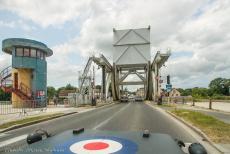
Classic Car Road Trip Normandy, 75 years after D-Day: The Ford GPW Jeep crossing the new Pegasus Bridge in Ranville. After landing by glider in Normandy, the original Pegasus Bridge was the first object taken by the Western Allied forces on D-Day, this bridge was replaced by a much stronger and wider bridge in 1993. The new bridge was designed and constructed according to the original Pegasus Bridge.
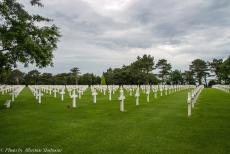
Classic Car Road Trip Normandy, 75 years after D-Day: The Normandy American Cemetery and Memorial at Omaha Beach in Colleville-sur-Mer, Normandy's most impressive war cemetery, is the last resting place of 9,387 American soldiers who lost their lives in the Battle of Normandy. A memorial in the 'Garden of Missing' carries the names of 1,557 soldiers who also lost their lives in the Battle of Normandy, they could not be identified or are reported missing in action.
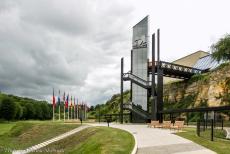
Classic Car Road Trip Normandy, 75 years after D-Day: The Memorial de Caen was built over a German bunker complex. In 1944, the bunker was the staff headquarters of the Commander of the German 716th Static Infantry Division, Generalmajor Wilhelm Richter. The bunker played an important role during the nazi-German occupation of France and the Battle of Normandy. The bunker presents the history of the Atlantic Wall and the nazi-German Occupation.
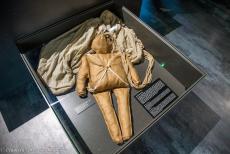
Classic Car Road Trip Normandy, 75 years after D-Day: Memorial de Caen, paradummy Rupert. Just before D-Day, the RAF dropped hundreds of Rupert paradummies in four locations over Normandy, the paradummies were designed to explode when they hit the ground. The purpose of this action was to confuse the German command over the actuel landing zones in Normandy. Almost at the same time, thousands of Allied paratroopers landed in the correct drop zones.
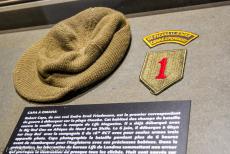
Classic Car Road Trip Normandy, 75 years after D-Day: Memorial de Caen Museum, the woolen commando jeep cap of the war photographer Robert Capa. On D-Day, Capa landed on Omaha Beach with nothing more than three cameras. Robert Capa took photos of the action on the beach for more than six hours before he returned to England. Due to a mistake of a photo lab assistant, 98 photos were destroyed, only eight photos were saved.
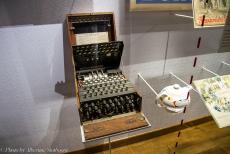
Classic Car Road Trip Normandy, 75 years after D-Day: Memorial de Caen Museum, the Enigma coding machine was invented by the German engineer Arthur Scherbius. The Enigma was used during the 1930s and during WWII by nazi-Germany to encrypt messages. Polish codebreakers cracked the Enigma Code, using French intelligence, much later British intelligence at Bletchley Park also cracked the Enigma Code. Deciphering the Enigma Code enabled the Allies to decode intercepted German messages, it probably shortened WWII.
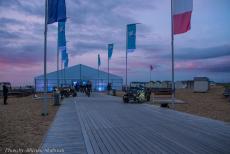
Classic Car Road Trip Normandy, the 75th anniversary of D-Day: On the 5th of June, we were invited to the Liberty Concert Normandy 2019, a memorial concert which took place on Sword Beach in Ouistreham. The Willys MB Jeep of a friend and our own 1942 Ford GPW Jeep were on display in front of the tent, where the memorial concert took place. The memorial concert took place on a location of Sword Beach where no Allied troops landed and no soldiers were killed in June 1944.
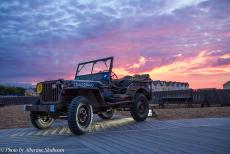
Classic Car Road Trip Normandy, the 75th anniversary of D-Day: A Willys MB Jeep on Sword Beach during the Liberation Concert Normandy 2019. The concert was attended by dignitaries, among them the Mayor of Ouistreham, a former Supreme Allied Commander of NATO, and veterans of the Princess Irene Brigade, a Dutch military unit during WWII. The Princess Irene Brigade landed at Arromanches-les-Bains and Courseulles-sur-Mer in 1944 and fought in the Battle of Normandy. In June 2019, five veterans of the Princess Irene Brigade were still alive.
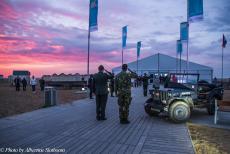
Classic Car Road Trip Normandy, the 75th anniversary of D-Day: Our own Ford Jeep on display in front of the tent, where the Liberation Concert Normandy 2019 took place, a memorial concert in honour of the soldiers who fought for the liberation of Europe during WWII, especially for those who landded on the beaches of Normandy in June 1944. At sun down, two soldiers hold the salute during the sounding of the Last Post. After playing the Last Post, a moment of silence was held as a gesture of respect to the fallen soldiers of D-Day and the Battle of Normandy.

Classic Car Road Trip Normandy, the 75th anniversary of D-Day: Daks over Normandy. For the first time since WWII, more than thirty Douglas DC-3 and DC-47 Skytains, commonly known as Dakotas, crossed the English Chanel to commemorate the 75th anniversary of D-Day. About 250 parachutists were dropped over Normandy, at the same locations, where 24.000 Allied Airborne troops were dropped in the early hours of D-Day, the 6th of June 1944. Two veterans jumped in a tandem and landed on the Normandy soil where they had landed 75 years earlier on D-Day.
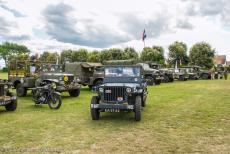
Classic Car Road Trip Normandy, the 75th anniversary of D-Day: Our Ford GPW Jeep in front of a row of WWII military vehicles. On 6 June 2019, the 75th anniversary of D-Day, a static show of authentic WWII military vehicles was held in Courseulles-sur-Mer, organised by Keep them Rolling, a Dutch association for historic WWII military vehicles owners. The show was mainly held for the Canadian students who attended the international commemoration ceremony for the 75th anniversary of D-Day on Juno Beach.
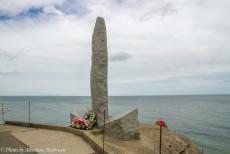
Classic Car Road Trip Normandy, 75 years after D-Day: WWII Pointe du Hoc Ranger Monument. Pointe du Hoc is one of the most impressive locations of the Atlantic Wall, Pointe du Hoc is a 30 metres high cliff overlooking Omaha Beach and Utah Beach. The U.S. Army Rangers sustained heavy losses during the D-Day landings, of 225 Rangers that left the Allied landing crafts in the first wave to attack Pointe du Hoc, only 90 Rangers were still able to fight when the relief force arrived on the 8th of June.

Classic Car Road Trip Normandy, 75 years after D-Day: The remains of a German WWII casemate at Pointe du Hoc. At the end of 1942, the Germans had installed a artillery battery at Pointe du Hoc. The battery on Pointe du Hoc was able to cover the two beaches on the Normandy coast, that later by the Allies had been selected for the landing of the American troops, the Allied code-name for these two beaches was Omaha and Utah. Today, Pointe du Hoc is still scattered with bomb craters, caused by heavy Allied bombing just before D-Day.
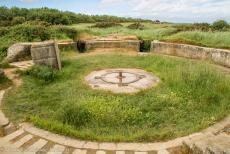
Classic Car Road Trip Normandy, 75 years after D-Day: The remains of an open concrete gun pit at Pointe du Hoc. The German battery at Pointe du Hoc consisted of an observation bunker and six 155 mm guns placed in the open gun pits, the guns were later covered by casemates built in concrete. In June 1944, after the successful attack by the U.S Rangers on Pointe du Hoc, no guns were found at Pointe du Hoc. After an Allied bombing in April 1944, the guns had been removed by the Germans and positioned elsewhere.
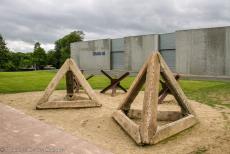
Classic Car Road Trip Normandy, 75 years after D-Day: The Overlord Museum at Colleville-sur-Mer. The museum is situated nearby Omaha Beach. The Overlord Museum recalls the Allied landings on 6 June 1944 until the liberation of Paris on 25 August 1944. The collection consist of over thirty WWII military vehicles from all the armies in Normandy during WWII, motorbykes, weapons, small personal belongings of soldiers, posters and documents of WWII. Several tanks and other WWII objects are placed on the museum grounds.
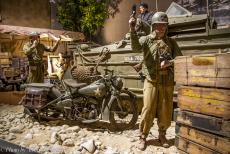
Classic Car Road Trip Normandy, 75 years after D-Day: One of the many dioramas in the Overlord Museum at Colleville-sur-Mer in Normandy. The Overlord Museum was opened in 2003. The impressive collection of WWII objects was gathered by the Frenchman Michel Leloup, a witness of the Battle of Normandy, at the time Leloup was 15 years old. The collection on the grounds surrounding the museum consists of a Bailey Bridge, a M32B1 Sherman Tank, a M10 Tank Destroyer and a Sexton self-propelled gun.
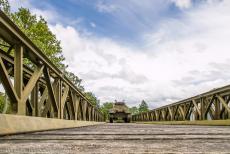
Classic Car Road Trip Normandy, 75 years after D-Day: A Sherman M32B1 on the Bailey Bridge at the Overlord Museum in Colleville-sur-Mer. The Sherman M32B1 was an Armoured Recovery Vehicle (ARV) used by the U.S. Army during WWII and later also during the Korean War. A Bailey Bridge is a pre-fabricated bridge, developped in the beginning of the 1940s by British engineers for military use during WWII, the wood and steel elements of the bridge were light enough to be carried by hand. Bailey Bridges are strong enough to carry tanks.
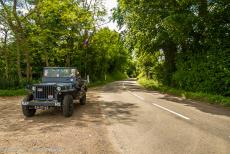
Classic Car Road Trip Normandy, 75 years after D-Day: A Ford GPW Jeep driving along one of the holloways, or sunken lanes in Normandy. During the Battle of Normandy, the Allies encountered heavy opposition from the German troops in the Normandy bocage landscape, the labyrinth of tiny fields and orchards surrounded by thick hedges and winding holloways was ideal for the Germans to defend. This 'Battle of the Hedgerows' took place in July 1944. Hedgerow warfare was common in the last days of WWII.
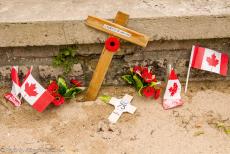
Classic Car Road Trip Normandy, the 75th anniversary of D-Day: A small Remembrance Poppy Cross placed in front of the Canada House at Bernières-sur-Mer in Normandy. The red poppy became the symbol to the fallen soldiers of WWI, because poppies bloom in large numbers on the battlefields of Flanders. The Remembrance Poppy was inspired by one of the best known WWI poems 'In Flanders Fields' by John McCrae. Now the poppy is a memorial symbol to fallen soldiers worldwide.
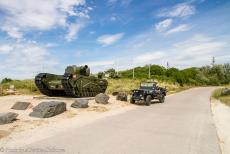
Classic Car Road Trip Normandy, 75 years after D-Day: A Churchill AVRE on Juno Beach at Graye-sur-Mer remains as a memorial to those who gave their lives here. The Churchill AVRE was a famous British tank during WWII. AVRE is short for Armoured Vehicle Royal Engineers. This tank landed on Juno Beach at Graye-sur-Mer on D-Day, it was stopped on its way inland, it sank into a four metres deep bomb crater where it remained buried for 32 years, the crew members were killed or seriously wounded. It was not until 1976 before the tank was unearthed and restored.
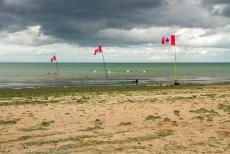
Classic Car Road Trip Normandy, the 75th anniversary of D-Day: During a commemorative ceremony at the Canada House in Bernières-sur-Mer, Canadian flags were placed alongside each other on Juno Beach. The ceremony was held to commemorate and honour the Canadian soldiers who were killed during the D-day landings on Juno Beach and those who fell during the Battle of Normandy. By the end of the Battle of Normandy, more than 5,000 Canadian soldiers were killed, most of them were buried in Canadian war cemetries in Normandy.
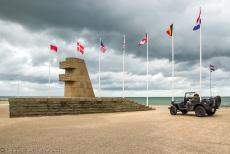
Classic Car Road Trip Normandy, 75 years after D-Day: Our own Ford GPW Jeep in front of the Monument 6 June 1944 in Bernières-sur-Mer, Normandy. The monument commemorates the first step of the Western Allied forces on French soil on D-Day. The text on the monument says 'Here on the 6th June 1944 Europe was liberated by the heroism of the Allied forces'. The monument is situated next to the Canada House and facing Juno Beach, where the Queen's Own Rifles of Canada landed on D-Day.
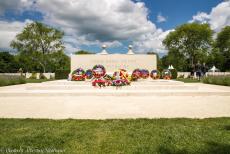
Classic Car Road Trip Normandy, the 75th anniversary of D-Day: The Bény-sur-Mer Canadian War Cemetery is the last resting place for 2,048 fallen soldiers. The war cemetery contains the graves of Canadian soldiers killed during the D-day landings on Juno Beach and killed during the first days of the advance on Caen. The cemetery also contains four British graves and a French grave, belonging to a resistance soldier who fought alongside the Canadian soldiers. The Bény-sur-Mer Canadian War Cemetery contains the graves of nine sets of brothers.
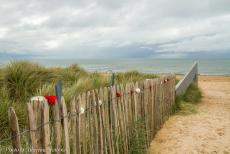
Classic Car Road Trip Normandy, the 75th anniversary of D-Day: During the 75th anniversary of D-Day, Canadian students decorated the entrance to Juno Beach with red and white flowers, the colours of the Canadian flag, in honour to the 3rd Canadian Infantry Division who landed at Juno Beach on D-Day, the 6th June 1944. This opening in the dunes in front of the Juno Beach Centre is filled with a symbolic steel structure shaped like a landing craft, the memorial monument is dedicated to the French Resistance.
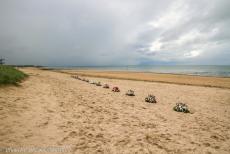
Classic Car Road Trip Normandy, the 75th anniversary of D-Day: On 6 June 2019, it was exactly 75 years ago that D-Day took place, the Allied landings on the beaches in Normandy during WWII. D-Day was the beginning of the liberation of Nazi-Germany occupied Europe. Within the 24-hour period known as D-Day, nearly 5,000 Allied soldiers were killed. During a memorial ceremony on Juno Beach,floral wreaths were laid by government leaders, heads of state and veterans. D-Day was commemorated throughout Normandy.
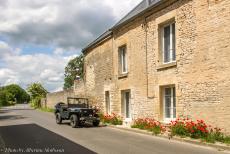
Classic Car Road Trip through Normandy during the celebrations of the 75th anniversary of D-Day: Our Ford GPW Jeep in front of a row of traditional French houses in a small village near Courseulles-sur-Mer. Our Ford GPW Jeep was produced by Ford in april 1942, he landed at Juno Beach in Normandy in June 1944. We restored the Ford GPW Jeep as a tribute to and in memory of the veterans of WWII. We don't use this Jeep for reenacting, only for WWII commemoration and celebration ceremonies.
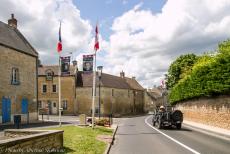
Classic Car Road Trip Normandy, 75 years after D-Day: Driving our own WWII Ford Jeep through the streets of a small village in Normandy. During the 75th anniversary of Day, hundreds of posters were placed along the roads in Normandy, France. The posters are titled 'Never Forget WWII Heroes'. Each poster shows a photo of one of the fallen soldiers of Normandy, his name and division. The posters are in memory of the soldiers who fought and were killed during the D-day landings and the Battle of Normandy in 1944.
